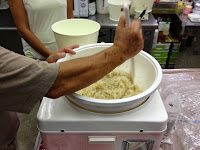As the year comes to a close, Japanese organizations plan events for coworkers to celebrate the past year called
bounenkai, 忘年会. This past weekend, those of us at the Yakuba went off to Osaka and Kyoto for a 2 day trip. Since I spend most of the day off at different schools, and the office isn't a place for socializing anyway, this was an ideal chance to interact with my coworkers. Overall, it was a great time, and I learned some new things about Japanese social behavior along the way.
 |
| Bingo programmed into the bus |
First, Saturday morning kicked off bright and early as we pulled out of the town hall parking lot at 7:30 a.m. Ten minutes later and the men were already cracking open beer cans and chilling in the back lounge area of the party bus. The two who had organized this trip did a great job making sure people would be entertained as we were fully stocked on booze, snacks, and games.
Depending on the schedule you chose, you could either get dropped off in Kobe for some horse race gambling, or continue on to Osaka for a comedy show. I opted for the comedy show despite my reservations about how much I'd actually understand. The show was put on by a famous comedy troupe called Yoshimoto that apparently has venues all over Japan. It seems like the first half was a variety of stuff to showcase some new talent while the second half was a hilarious Christmas skit. When some colleagues later asked if I had understood what was going on, others who had been sitting next to me chimed in that I was laughing louder than everyone else. I apologized for the noise level, but I was pleased I had been able to follow the plot.
 |
Osaka is famous for its takoyaki (fried octopus)
Also a lot of fun to watch them make |
Now Osaka doesn't have much in the way of cultural sites. It's a destination for people wanting to shop and enjoy the nightlife. So after the show, people went their separate ways to spend the time until dinner. Once dinner started, the beer kept flowing until dessert. Drinking in Japan is something else. I don't really know how to put it. People are constantly refilling your glass before you even finish all of it because you don't pour for yourself. "Oh no! Your glass is half-full, let me top you off. Some coworkers went too hard too quickly and tried to signal no more drinks by keeping their glasses full. NOPE! When that bottle came around you were expected to take a sip so at least some could be poured in again. After dinner had concluded, people once again went their separate ways. I went off to a karaoke bar with some others and sang for two hours. I do love me some karaoke.
Now you might be thinking, "Wow! That sounds like you had a great bonding experience." After all, in America, sometimes a drunken night will lead to a new friendship. Or you may never talk to that person again once you're sober. Japan is a lot like the latter. What happens when you're drunk, stays there. So even though I rocked out to some 80's classics with my bosses, I can't act all chummy with them the next day. Also, fortunately for those that got totally smashed at dinner, there is no public shaming the next day.
On Sunday, we set off for nearby Kyoto. What Osaka lacks in culture, Kyoto makes up for tenfold. Kyoto has the largest population of working geisha in Japan, and it's not uncommon to see men and women walking around wearing traditional kimonos. There seems to be a famous temple or shrine of some sort every half a mile, and some smaller ones tucked in between commercial buildings. First, I went off to Fushimi Inari shrine and later met up with everyone else at the temple Kiyomizudera.
Fushimi Inari is one of my favorite shrines because of the thousands of
torii gates that you walk through as you ascend the mountain. Since it is a shrine, it is related to the Japanese religion Shinto. Shinto is a little ambiguous with each deity's role, so Inari is the god/goddess of business and many other things. The inscriptions you see on the
torii gates show the patrons who donated the money to the shrine.
The Buddhist temple Kiyomizudera has a variety of things going for it to attract visitors. The photo at the top shows a fountain that will grant a long healthy life and wishes and other good things if you drink from it. So of course I did, and you can see people extended their cups out under the water. Even though this is a Buddhist temple, religions often overlap in Asian societies. Within the temple grounds there is a shrine to the Shinto god of love and matchmaking. At this shrine there are two rocks about 20 ft apart, and if you can walk from one to the other with your eyes closed, the myth is you will find true love. People rarely do that one for fear of ridicule.



























